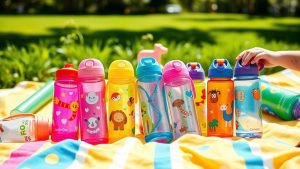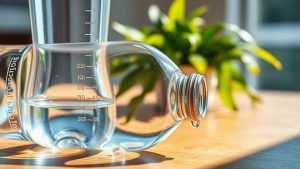
Water bottles come in a variety of sizes, ranging from 8 ounces to 64 ounces. Smaller sizes, like 8-ounce and 12-ounce bottles, are perfect for kids or short errands. The 16-ounce and 16.9-ounce bottles are popular choices for everyday use, while larger bottles, like 32 to 64 ounces, cater to those with extensive hydration needs. Choosing the right size can greatly enhance your hydration experience. Want to know more about selecting the best water bottle for your needs?
Have you ever wondered how many ounces are in a typical water bottle? When it comes to water bottles, sizes vary greatly, and understanding these differences can help you choose the right one for your needs. The most common sizes range from 8 ounces to 64 ounces, catering to various hydration requirements and activities.
Water bottles come in various sizes, from 8 to 64 ounces, to suit different hydration needs and activities.
For quick sips or small refreshments, an 8-ounce bottle is ideal. This size is perfect for kids or short errands when you don't need a lot of water. If you find yourself needing a bit more hydration without the bulk, a 12-ounce bottle is a step up. This size offers a comfortable amount of water while still being easily portable.
However, if you're looking for the standard serving, the 16-ounce bottle is the most popular choice. It fits well in most car cup holders and bags, making it convenient for daily use. You might also come across 16.9-ounce bottles, which are frequently referenced in discussions about standard bottled water. These bottles are just slightly larger than 16 ounces and are commonly found in stores and vending machines.
For those who require more than 8 ounces but less than 12, a 10-ounce bottle meets that in-between need effectively. When considering dimensions, water bottles typically range from 7 to 12 inches tall, with diameters designed to fit standard car cup holders. For instance, an 8-ounce bottle usually stands between 5 to 6.5 inches tall and has a diameter of about 2.25 inches.
A 12-ounce bottle, on the other hand, is typically around 6.25 to 6.75 inches tall, maintaining a similar diameter. The 16.9-ounce bottles are generally 8 to 8.25 inches tall, also with a diameter of 2.25 to 2.5 inches. Larger bottles, such as those containing 32 to 64 ounces, cater to extensive hydration needs, especially for active individuals or groups. Choosing the right size for your water bottle can enhance your hydration efforts throughout the day.
For your daily activities, bottles in the 16 to 20-ounce range are often sufficient, while those starting on adventures might prefer bottles of 40 ounces or larger. The materials used in water bottles also play a considerable role in your choice. Many bottles are made of BPA-free plastic for lightweight convenience, while stainless steel options are favored for their insulation and durability.
Glass and aluminum bottles present non-plastic alternatives, each with its benefits. Insulated bottles keep drinks at the desired temperature, while non-insulated versions are lighter and often more portable. Finally, when it comes to packaging, smaller bottles like the 8-ounce are often sold in multipacks, while 12-ounce and 16.9-ounce bottles are typically sold by the case.
Understanding the variety of bottle sizes and their intended uses can help you make informed choices based on your hydration needs and lifestyle. Whether you're picking a bottle for a workout, a day trip, or just for convenience, knowing the ounces in a water bottle can enhance your hydration experience.
Conclusion
In conclusion, while water bottles come in various sizes, the most common ones typically hold 16.9 ounces, or 500 milliliters. This amount serves as a convenient measure for staying hydrated throughout the day. So, next time you reach for a bottle, remember that it's not just a vessel; it's a small step toward your health goals. Embrace the simplicity of hydration, and let each sip remind you of the essential role water plays in your well-being.



